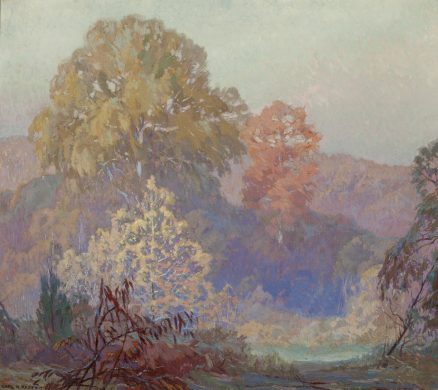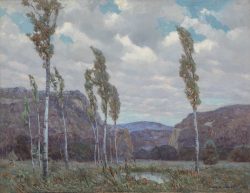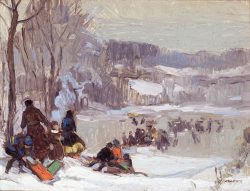- Categories
- Landscapes
- Zoom in on Artwork
- Print Page
- Email Page to Friend
Krafft’s Arcadia or Autumn Symphony seems calculated to show off a variety of forms and tints in a stand of trees bathed in the benign light of an Indian summer afternoon. The stronger color of the low vegetation in the shadowed foreground sets off the hazy glow of the sunstruck trees beyond. Between them, an area of glowing turquoise at the lower right perhaps indicates a rushing stream illuminated by direct sunlight. The composition’s layering of near and distant elements is characteristic of the decorative landscape paintings of Krafft and other members of the so-called Society of Ozark Painters in the 1910s and early 1920s.
A label affixed to the back of the painting gives two titles, Arcadia and Autumn Symphony. The former links the pristine beauty of this scene with the ideal landscape of classical poetry. Krafft favored such evocative titles for his romantic early landscapes, but here Arcadia also refers to an actual place, the Arcadia Valley in the Ozark Mountains region of Missouri, where the artist had a studio in the village of Knob Creek. Between 1913 and 1920 Krafft was closely identified with the scenery of the Ozarks, where he found a perfect place to realize a sublime natural beauty on canvas. He wrote ecstatically of its “langorous [sic] blue haze like a translucent veil of finest silver”; as if speaking of this particular painting he added: “The sunbeams strike through this veil, touching the scarlets of maple and sumac, the gold of hickory and elm and the shades of brown of the oaks till all the hills glow as if a thousand rainbows had been shattered and sown broadcast by a giant hand.”i The relatively undramatic scenery presented here seems less a focus of interest in itself than a vehicle for such atmospheric effects.
Krafft’s reuse of titles and reluctance to date his canvases complicate the dating of this painting. He exhibited a work entitled Arcadia in the Art Institute of Chicago’s 1918 annual exhibition for American art; a painting called Autumn Symphony was shown the following year in the museum’s “Chicago and Vicinity” show and again in Krafft’s solo exhibition at the Art Institute in 1920. A reviewer of the 1918 show described Arcadia as “exceptional as a painting of the happy valley of Missouri in decorative arrangement and color.”ii The present painting may be any one or all of these exhibited works, but it could also date to the following decade, for a closely related painting entitled Autumn Symphony is reproduced in Krafft’s daughter’s 1941 biography as a work of 1924. By that date, however, Krafft is thought to have abandoned the Ozarks for other painting locales, among them Galena and Willow Springs, Illinois.
Wendy Greenhouse, PhD
Donated by M. Christine Schwartz to the Oak Park River Forest History Museum, Oak Park, Illinois, in 2021
i Krafft quoted in Lena McCauley, “A Painter Poet of the Ozarks,” Fine Arts Journal 34 (Oct. 1916): 470.
ii Lena M. McCauley, “Artists of the West Growing in Numbers,” Chicago Evening Post, Nov. 26, 1918.


